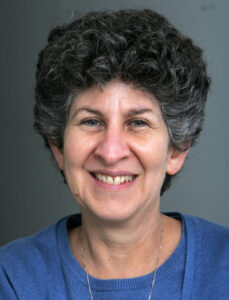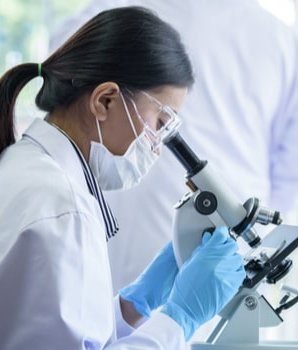Where Do You See Society in 50 Years?
The Difficulty of Predicting the Future of Scientific Innovation…
 One of the most difficult parts of science is predicting the future of the field and anticipating life-changing innovations, acknowledged Drs. Ruth Stark (Chemistry), Parameswaran Nair (Physics), and Mitch Schaffler (Biomedical Engineering), Distinguished Professors at the City College of New York.
One of the most difficult parts of science is predicting the future of the field and anticipating life-changing innovations, acknowledged Drs. Ruth Stark (Chemistry), Parameswaran Nair (Physics), and Mitch Schaffler (Biomedical Engineering), Distinguished Professors at the City College of New York.
The global influence of groundbreaking scientific innovations has led many to speculate and predict what discovery or innovation will steer the direction of our contemporary society for decades to come.
Dr. Schaffler recounts, “In the late 1960s, early 70s, there were a number of social scientists who were very much involved in predicting the future, they became called futurists. And then it turned out to be enormously profitable for the people who wrote the books, but probably has had very little impact on predicting what actually occurred.”
Much of the technology and innovations in medicine and engineering that define contemporary life were not foreseen by these futurists.
“What actually occurred, at least in the science and technology areas, was like anything else: something was discovered, and all of a sudden, a new opportunity presented itself, a new way to do things, we’re deliberately careful about how we do research, but there’s always something fortuitous about discovery.”
Advancements in the sciences are often gradual, and there is no infallible way of knowing which of today’s innovations will become tomorrow’s totalities. Dr. Schaffler highlighted the significant increase in life expectancy in the Western world over the past century, as being largely due to separate breakthroughs in medicine and quality of life innovations that improved public health and hygiene.
The other component complicating predicting future scientific discoveries is speculating about which modern-day innovations that people previously thought they could never do without will lose relevance over time. Currently, the auto industry is moving toward increased production of electric cars, a result of sustainability efforts aimed at reducing carbon emissions from popular commodities. But the “electric future” promoted by the biggest auto manufacturers may not be as feasible as it is portrayed. 
But amidst the volatility of innovation and discovery, the distinguished professors acknowledge that some trends are more discernable than others. They agree that academic disciplines are gradually becoming less siloed, leading to researchers adopting interdisciplinary approaches to their work, which unlocks potential for further discoveries. One example of this overlap is the career of Dr. Stark, who was originally trained as a physical chemist, but then transitioned to working on macromolecular assemblies in natural systems.
And at the foundation of all scientific innovation and breakthroughs is the tireless research done by experts today in hopes of building a better tomorrow.
“We know that research in science, and development in technology, that’s what has transformed our society over the last few centuries. And of course, there are many societal problems today, and they’re not going to be solved without further research,” Dr. Nair emphasizes.
“But curiosity is something that is inherent to humans, so we have a fundamental quest to understand things. So given that you need, on the one hand, research to solve some of our problems, and that inherently we are curious people, there is no question that researching will be there playing a dominant, perhaps a more extensive role than it does today.”
Scientific research with the goal of making the world a better place is exactly what the three distinguished professors hope to continue fostering at CCNY.
Discussing Energy Alternatives
Rising fuel prices, carbon emission concerns, and increasing calls for energy independence have led to speculation on how to address these persisting challenges in providing adequate energy sources for our society amid increasing demands for clean energy sources.
The push toward electric vehicles and away from fossil fuels is one of the major efforts global leaders hope to address climate change and carbon emissions. Detroit’s Big Three automakers plan for 50% of new vehicle sales to be electric by 2030.
Racing towards EVs (electric vehicles) as a zero-emission “green” solution may be ill-advised, however, as electric power isn’t as clean as one may think, says Dr. Schaffler.
There’s not enough solar and wind energy to power all the electric cars that we’re talking about, and the homes in New York City and every other place in the country. So somebody is burning fossil fuels to create more electricity.
 Depending on the region, electricity can be produced by zero-emission wind and solar power sources, but it can also be derived from burning coal, natural gas that emits carbon dioxide, or nuclear sources that produce nuclear wastes.
Depending on the region, electricity can be produced by zero-emission wind and solar power sources, but it can also be derived from burning coal, natural gas that emits carbon dioxide, or nuclear sources that produce nuclear wastes.
Batteries also contain toxic materials that must be disposed of or recycled properly to avoid potential damage to the environment. If market estimates come true and millions of EVs are purchased by 2030, additional fossil fuel burning will be required to meet the increased energy demands.
There is also worry that current energy systems may not be capable of providing the wattage to charge the millions of EVs expected in the garages of American households by the end of the decade. Dr. Schaffler believes that hydrogen fuel-cell vehicles can potentially be a viable solution to address that gap since hydrogen is abundant and their only emission is water.
Dr. Nair suggests that another solution to consider is reviving nuclear energy as a bridge technology. These technologies could prevent geopolitical conflicts between countries to secure fossil fuels especially as other countries develop and increase their energy demands.
Disruptions and paradigm-shifting energy production technology can also occur at any moment in pursuit of an ideal energy source. Dr. Schaffler pointed out that past researchers at the UK-based JET Laboratory achieved a nuclear fusion reaction recently.
Scientists were able to produce 11 megawatts of power over five seconds by heating atomic nuclei to temperatures of 100 million Celsius to create a fusion reaction. If researchers are able to create power over longer, sustainable periods of time, it could lead to an energy source that produces little carbon emissions and radioactive waste.
Dr. Stark shared that research at City College is underway to provide cleaner energy solutions as well. Chemistry professor George John has spent years investigating green batteries, with energy cells made of organic materials, which are more efficient and less damaging to the environment.
She also added that since research silos are breaking down and scientists from different disciplines are interacting with each other more, there is greater potential for future breakthroughs.
However, Dr. Nair countered that promising technologies depend on long-term funding, policy, political and public support to address the challenges of making innovations. This can be accomplished by more effectively communicating how these innovations can positively benefit consumers and society at large, a larger challenge given the potential of disinformation to rapidly spread.
No private company is going to invest in something like [nuclear fusion] with no foreseeable return for the next 15 to 20 years. That is the kind of thing that calls for government funding with a long-term view and commitment. We have to build public support for people have to understand science and value what they see us trying to do.
Discussing How to Improve Scientific Literacy
Over the years, misunderstandings in science have led some people to reject scientific information or become skeptical of it. Misunderstanding of science created misinformation on how vaccines and diseases work during the coronavirus pandemic. Conversely, Americans with an understanding of scientific knowledge tend to trust that scientists act in the best interest of the public, according to a finding in a Pew Research Center study from August 2019. This means those that have scientific literacy are more willing to base their decisions on data.
One way to improve science education and communication, the three Distinguished Professors agreed, is for scientists to lessen the use of scientific jargon when speaking to peers and the general public at large. Overuse of highly technical terms can make communicating scientific facts and findings challenging.
Taking a broader approach to tackling science communication is important. Dr. Mitchell Schaffler pointed out that scientists are used to writing grants, articles, and reports in order to disseminate research findings. To help develop sound public policy and influence public perspectives with these findings, scientists have to be able to explain their research outcomes to everyone. “One of the key pieces is, we need to improve the way scientists communicate. We’re selling our ideas to a very narrow audience.”
 At an educational level, Dr. Schaffler also believes that educators and scientists should revisit how science is being taught in schools in order to reevaluate if the information is being taught effectively. He pointed out that science courses could be changed to include more societal aspects, which may help people better interpret what they are learning.
At an educational level, Dr. Schaffler also believes that educators and scientists should revisit how science is being taught in schools in order to reevaluate if the information is being taught effectively. He pointed out that science courses could be changed to include more societal aspects, which may help people better interpret what they are learning.
You know, for everyone, not just science majors, maybe the humanities majors and the social sciences majors need to learn about science, art and technology together.
Dr. Ruth Stark believes we should think about improving communication in smaller steps. Scientists should speak to people, she said, where they are – which means, among other things, finding meaningful hooks to pique students’ interests. By doing so, students can better relate to science and retain it.
In her classes, she has seen the effectiveness of encouraging students to think about how science is linked to their personal lives. “I had the students make many presentations on applying the principles of thermodynamics to some problem they were interested in.”
 Stark posited that scientists should go to young students, at the elementary and junior high school levels, and talk about their own scientific journeys. This could help scientists minimize their use of jargon and find ways to inspire students to get into science, as well as give scientists a chance to follow up with what the students are expressing interest in, scientifically.
Stark posited that scientists should go to young students, at the elementary and junior high school levels, and talk about their own scientific journeys. This could help scientists minimize their use of jargon and find ways to inspire students to get into science, as well as give scientists a chance to follow up with what the students are expressing interest in, scientifically.
You know the first pass, you can be superficial. You want to grab them, but then you have to follow up, which is much harder. If you stay at the superficial level, then I think you go very quickly into the disinformation regime.
Dr. Schaffler stressed the importance of his and Stark’s points by using vaccine hesitancy as an example. Throughout the pandemic, there was a rise in vaccine hesitancy. One reason for this was the spreading of misinformation, such as the myth that mRNA vaccines alter genetics. He said for people in science, this idea sounded silly, but to the larger population, a claim like this carried on, despite scientists addressing it and people having learned in school the basics of how DNA operates.
Another way to enhance science education is to provide students with a basic foundation of scientific information, regardless of what career each student chooses, Dr. Parameswaran Nair said. He believes this could allow people to build an appreciation for science and how it affects society.
Science is a process. It’s not a set of things that we can declare as being religiously true forever.
 Battling disinformation, whether on a general or specific scale, can be done if scientists take responsibility for the role they play in communicating with the public. Taking the initiative to challenge curriculum in schools, making science simpler for people to digest, and directly going after young minds are all ways to convince the next generation to explore science. This can be enhanced if scientists share the defining moments that convinced them to pursue their careers, which can not only make science inspirational but also help people gain insight into the people behind the science.
Battling disinformation, whether on a general or specific scale, can be done if scientists take responsibility for the role they play in communicating with the public. Taking the initiative to challenge curriculum in schools, making science simpler for people to digest, and directly going after young minds are all ways to convince the next generation to explore science. This can be enhanced if scientists share the defining moments that convinced them to pursue their careers, which can not only make science inspirational but also help people gain insight into the people behind the science.
What First Made CCNY Distinguished Professors Pursue Science Careers
What makes people want to pursue science as a career?
Substantial time and research have been devoted to finding answers to this question. While there isn’t a universal solution to the issues, studying those already in the field can provide key insights. The RICC team posed this question to our Distinguished Professors and asked them when they first realized they wanted to pursue a career in science.
One common element across the interviews was the interest in science at a young age. Even as a child, Dr. Stark knew that she liked science. When she started college, she was torn between chemistry and economics. She finally chose chemistry because it posed more of an intellectual challenge.
“My first semester (of organic chemistry) was a disaster.” Dr. Stark said. “One of the things that convinced me that this was the field from me was coming back from that disaster.”
Conversely, Dr. Schaffler grew up loving such disparate subjects as paleontology, mechanics, and marine biology – shell structures in particular. Parameswaran Nair also had an interest from a young age, though not necessarily in science: growing up, he often competed with his older cousin in a rivalry of one-upmanship, and science was often included in that competition.
The professors all received encouragement early in their development. For Dr. Stark, that encouragement came when she observed her thermodynamics professor teach in graduate school. The professor, she said, would teach his class how to think, showing them how to work through a problem in five different ways. This helped push her to pursue a career as a professor. A professor in Dr. Schaffler’s undergraduate years involved him in research focused on skull morphology and mathematical approaches to skull structure. Dr. Nair’s encouragement came from his peers. When he was in 7th grade, Dr. Nair began meeting with a group of students in his hometown in India – without any adult prompting them – to discuss physics and math.
When describing these meetings, Dr. Nair said, “One thing that really helps people learn, at least in my experience, is having a lot of peers who have the same interests. There’s this dynamic, that you try to learn from others, but also you want to be a little better than the others, and it works out.”
 Finally, hands-on work was an important factor in the professors’ choice to pursue science as a career. Dr. Stark’s experience came from laboratory work – as an undergraduate, she worked in an organic chemistry lab, and cites this time as influencing her later choice to pursue a career in science.
Finally, hands-on work was an important factor in the professors’ choice to pursue science as a career. Dr. Stark’s experience came from laboratory work – as an undergraduate, she worked in an organic chemistry lab, and cites this time as influencing her later choice to pursue a career in science.
Dr. Schaffler’s hands-on experience came from his skull morphology work as an undergrad.
“And then somewhere along the way, I had an undergraduate professor who got me involved in research that involved looking at morphology and mechanical approaches to skeletal structure. And I said, ‘This is extremely cool!’ And It just sort of made sense to me. Also, he showed me you could make a living doing stuff like this.”
Dr. Nair’s hands-on experience comes back to his rivalry with his cousin. When his cousin said he knew how an electric motor worked, Nair on his own, sought out information so he could also see how it worked. Once he did, his interest in science, and physics, in particular, was piqued.
Each of the interviewed professors had different “light bulb moments”, that convinced them to pursue science as a career. One of the most apparent revelations from these interviews is that science is not accomplished in a vacuum. Chances to work in the field and associate with their peers, as well as receive guidance, seem incredibly important in encouraging people to pursue science as a career. These commonalities may serve as enlightenment for those encouraging others to consider pursuing science as a career.